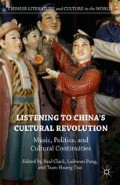Abstract
In the existing literature on the Chinese seven-stringed zither qin, historical approaches often stop short of exploring post-1966 developments, while ethnographic approaches routinely elaborate findings from the 1980s onward. Consequently, the qin during China’s Cultural Revolution remains under-researched. In his 1982 history of the qin, Xu Jian (1923) only uses half a paragraph to describe what happened during this period, stating thus:
Qin activities were very discontinuous in mainland China due to a group of older qin players tragically dying in this huge wave of opposition and even the few who were fortunately still alive at the end of this period were forced to give up their beloved instrument.1
Access this chapter
Tax calculation will be finalised at checkout
Purchases are for personal use only
Preview
Unable to display preview. Download preview PDF.
Notes
Jian Xu, A Brief’History of’the Qin (Qinshi chubian) (Beijing: Renmin yinyue chubanshe, 1982), 194.
Zhang is a well-known Shanghai qin player who taught at the Shanghai Conservatory of Music. His diary is an important source for understanding the modern history of the qin, but, sadly, the part written during the Cultural Revolution is missing. Zhang often uses abbreviations when referring to names of qin repertories—for example, “Pingsha” for “Pingsha Luoyan.” For more information, see Ziqian Zhang, My Diary and the Qin (Caoman suoji) (Beijing: Zhonghua shuju, 2005).
Chen Lin, ed., Sixty Tears of Study on the Qin (Qinxue yanjiu liushi nian) (Beijing: Wenhua yishu chubanshe, 2011).
See Chen Lin’s paper, “Unprecedented or Distinguished? Interview of Qin Zither Performers in 1956” (Kongqian yihuo juehou—1956 Nianguqin caifang), Musicology in China 3 (2008): 43–51.
Research Institute of Music at the Chinese National Academy of Arts (Zhongguo yishu yanjiuyuan yinyue yanjiusuo) and Beijing Guqin Research Association (Beijing guqin yan-jiuhui) eds., Collection of Qin Handbooks (Qinqu jicheng) (Beijing: Zhonghua Shuju, 2010).
Gong Yi joined the Shanghai Orchestra (Shanghai yuetuan) to visit Australia and New Zealand, while Wu Wenguang took part in the Army Friends Arts Troupe (Zhanyou wengongtuan) to Japan. See Zhang Zhuo], “Qin qu “sanxia chuange” yanjiu”, Tianjin yinyue xueyuan xuebao 1 (2013): 76–83.
Even the timbre of the “pinewood (bigger size) qin” sounds wrong, according to several scholars who have heard the recording played during my academic presentations (this is compared with their experiences of antique or recently manufactured instruments). Li Xiangting, “Qixmnqin de kuoyin shebei ji jixie xmnzhou”, Tueqi keji jmnxun 1 (1974): 5–7.
Yi Gong, The Performance Techniques of the Guqin (Guqin yanzou fa, (Shanghai: Shanghai jiaoyu chubanshe, 1999).
Quan Zhu, Quxinn shenqi mipu (Shanghai: Shanghai guji chubanshe, 1995 [1425]).
Tsan-Huang Tsai, “‘Tradition,’ Internal Debates, and Future Directions: The Concept of Tradition and Its Relation to Time in the Practices of the Chinese Seven-Stringed Zither (Qin)” The Journal of Chinese Ritual, Theatre and Folklore 166 (2009): 97–124.
Editor information
Copyright information
© 2016 Tsan-Huang Tsai
About this chapter
Cite this chapter
Tsai, TH. (2016). From Confucianist Meditative Tool to Maoist Revolutionary Weapon: The Seven-Stringed Zither (Qin) in the Cultural Revolution. In: Clark, P., Pang, L., Tsai, TH. (eds) Listening to China’s Cultural Revolution. Chinese Literature and Culture in the World. Palgrave Macmillan, New York. https://doi.org/10.1057/9781137463579_3
Download citation
DOI: https://doi.org/10.1057/9781137463579_3
Publisher Name: Palgrave Macmillan, New York
Print ISBN: 978-1-349-56508-5
Online ISBN: 978-1-137-46357-9
eBook Packages: Literature, Cultural and Media StudiesLiterature, Cultural and Media Studies (R0)

